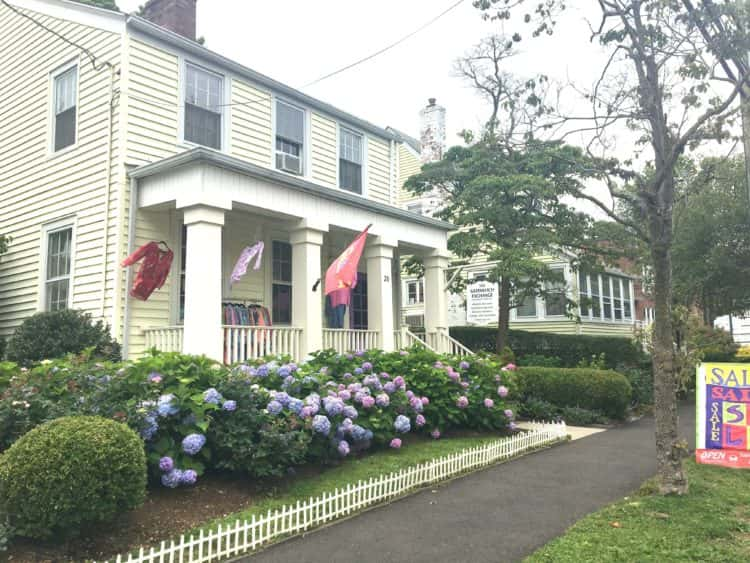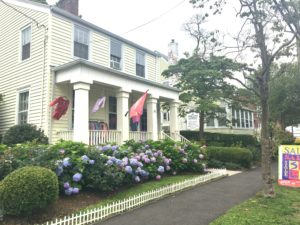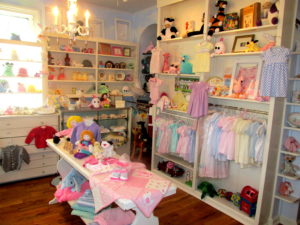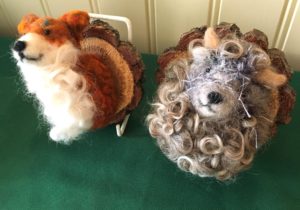
By Anne W. Semmes

Entering the Women’s Exchange of Greenwich you are met with the loveliness of childhood, handmade dresses with smocking, booties, crib quilts, and fetching stuffed animals.
Lots of handiwork here. Step into the next room and there are chic, colorful summer tunics for women, eye-catching jewelry, and curious furry animal plaques. Again, a lot of handiwork. For those who don’t know and should, this charming small columned house on Sherwood Place is bursting with hidden treasures, mostly made by women.
“This house was bought in 1934,” says Exchange President Veronica “Roni” Schmitz, but there’s been an Exchange in Greenwich since 1901. Of the three Exchanges located in Connecticut, including Southport’s Fairfield Women’s Exchange, and Old Lyme’s, Schmitz says the Greenwich Exchange is the oldest. Of 19 existing nationwide, the Brooklyn, NY Woman’s Exchange is the oldest at 1832.
So, what is the Exchange all about? It’s a non-profit venue for women hand crafters to sell their handiwork, run primarily by volunteers. “The consignor gets 67 percent of asking prices,” says Schmitz, “with 33 percent going to operating expenses and local charitable contributions.” Add to this mix an enchanting cottage in the rear full of enticing and often rare consigned antiques.
But it’s the women crafters that intrigue this reporter. Who is making those captivating plaqued woolly animal heads – a fox and a sheep caught the eye, not cheap at $75 each, but they’re works of art. “It seemed easy to mold them and make them come alive,” tells crafter Lisa Hodges in her downtown house. Her art teacher Hazel Jarvis had introduced her to felting at the Greenwich Botanical Center. “I loved it. I started making a dog. It became a cat.”
Hodges figures she’s made perhaps 80 of the woolly animals over the last eight years. She shows me a wild boar in progress. “One of its legs is loose.” She shows how she tightens the sheep’s wool by inserting her felting needle multiple times into the wool. She finds natural sheep’s wool at fiber festivals. She figures it will take her perhaps 15 to 16 hours to make the Boer. “They’re not for kids,” she says. The likely buyers are those, “who have the same fondness for the natural world.”
Hodges started selling her woolly crafts at the Exchange a year ago. “I love the atmosphere,” she says. “There are so many crafts, things made with love.” She’s surprised, she says, “It’s not the most popular place in Greenwich. It’s a little gem.”

Music boxes are irresistible, especially Brenda Dehmel’s. Hers are small – three inches by two plus inches, and dearly decorated. The one with chickens on it plays a favorite, “You are my sunshine.” Another has golden butterflies and plays “Clair de Lune.” They cost $17. Dehmel makes them nonstop in her backcountry house. She has been consigning them to the Exchange for at least 20 years, she says. With as many as 30 once ordered for Christmas gifts by the Fairfield Exchange (the word gets around) Dehmel is becoming anxious as her music boxes come from China. Will shipments be possible with the pandemic?
She depends on a wide array of music choices. “I have 15 or 16 for every day, and 15-16 for Christmas.” She collects old Christmas cards to decorate them with. “It doesn’t take long to make them,” she says, Maybe 20 minutes.”
She’s the one who rightly describes the Exchange as a “hidden treasure.” She adds, “It has beautiful things. It’s always doing something special for people. The people are really nice to deal with. And Roni is delightful.”
It was the turquoise square stones necklace that led me to Elaine Gencarelli’s apartment in Greenwich. “Those are druzy stones,” she said, “They’re normally pale blue. They bring in a positive energy.” Positive for sure – and at $46, one wants to take them home.
Gencarelli became bead-inspired while working years ago at the Maritime Aquarium in Norwalk, Nearby was a flagship Beadworks store “I started making stuff for myself,” she tells, until someone suggested she sell it. A chance meeting with Roni introduced her to the Exchange.

On a table in her living room Gencarelli had spread out her tools, her beads, and necklace in the making. Assorted pendants awaited selecting. “I can create a design for a necklace in a couple of days,” she says, “Then make it in an hour. I’ll make some 30 pieces a year, working nights and weekends. It’s a good stress release.”
She enjoys visiting those “amazing” bead shows in Manhattan twice a year. “If you’re a beader its quite like you’re in hog heaven. And there are bead classes at bead shows.”
Gencarelli has found time – she works as a media specialist – to volunteer at the Exchange for its Christmas sale. “I feel grateful to have found the Exchange,” she says, “and Roni in particular. During this pandemic she has done mail orders. She has kept it going as well as she could. I am in awe of her dedication.”
Perhaps the craft most speaking to the moment are Kristi Hutter’s animal muzzle face masks for kids. They’re crowd stoppers! Surely for kids, these $12 animal face masks beg to be worn. Hutter found the muzzle fabric in her favored Nimble Thimble shop in nearby Port Chester. “I wash the fabric, then iron it, then cut out the fabric from the pattern piece,” she tells. And there it all is set out neatly on her “Sewing Studio” worktable in backcountry Greenwich.
Hutter does this in her off time as secretary for the St. Michael’s Parish. She started making children’s face masks when Covid hit, she says. She’s found, “There is so much pleasure and joy in children. I’m having fun. It takes me half an hour to make a mask.”
Hutter met Roni Schmitz five years ago and was soon serving on the Exchange Board.
“I liked to sew and do crafts,” she says, “So, it’s very inspiring for me to be in the Exchange environment. It’s a beautiful place to be. Women come in and see everything and say, ‘I make things.’ It inspires them to make things. It shocks me people don’t know about the Exchange!”



